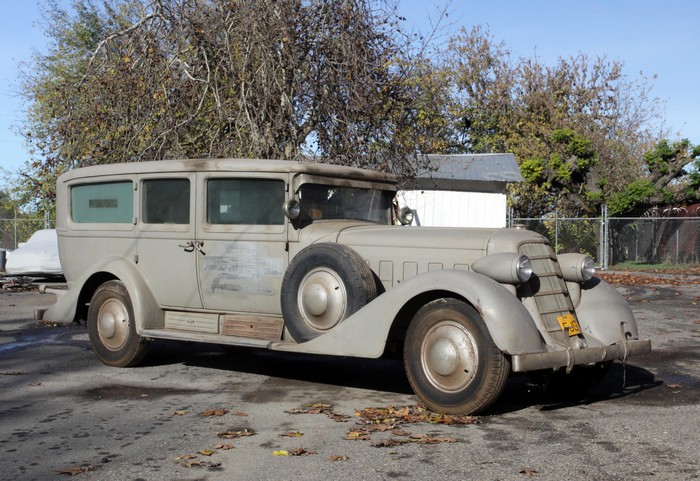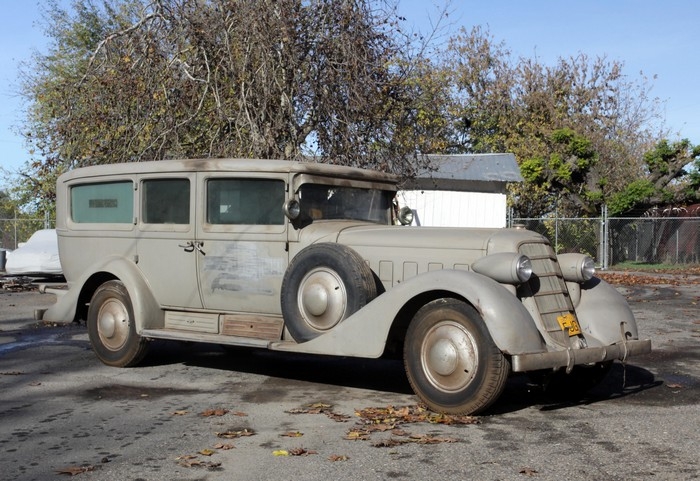
Quiet, strong, flexible and powerful, the Cadillac V16 defined luxury in the golden age of classic luxury automobiles. As brilliantly styled under the hood as its Harley Earl exterior, it exuded quality and exclusivity that were reinforced by the refinement of its drivetrain and chassis.
The Cadillac V16 was also durable, which explains the transformation of the 1930 Cadillac 452 V16 body style 4375S Fleetwood Four Door Sedan into an ambulance with a 1935 Cadillac V16 grille, hood, skirted front and rear fenders, and 1935 Cadillac 17-inch wheels, hubcaps and trim rings.
Cadillac V16s were too good not to keep in service, and the cost of updating was far less than a new ambulance. In the depths of the Great Depression, it simply made sense.
Preserved in original condition for many years in the Pierce A. Miller Carriage Collection, this Cadillac presents an intriguing challenge for collectors.
(Introductory description courtesy of Bonhams.)
SCM Analysis
Detailing
| Vehicle: | 1930 Cadillac 452 V16 ambulance |
| Years Produced: | 1930–40 |
| Number Produced: | 4,076 |
| Original List Price: | $6,225 (1930 Four Door Sedan) |
| SCM Valuation: | $30k–$45k (this condition) |
| Chassis Number Location: | Not used |
| Engine Number Location: | Right side of crankcase |
| Club Info: | Cad-LaSalle Club |
| Website: | www.cadlaclasalleclub.org |
| Alternatives: | Any unrestored Full Classic turned to working duty, including tow trucks, delivery vans and ambulances |
| Investment Grade: | D |
This 1930 Cadillac 452 V16 Ambulance with coachwork by Fleetwood, Lot 384, sold for $44,850, including buyer’s premium, at Bonhams’ Scottsdale auction at the Westin Kierland Resort and Spa in Scottsdale, AZ, on January 17, 2013.
Conceived in the glitter and glitz of the Roaring ’20s and delivered in early 1930 as the gloom of the Great Depression was settling over the land, the Cadillac V16 was an engineering marvel that never recovered its development cost.
It was offered in more than 50 body styles with a handful of full-custom bodies created by the leading coachbuilders. Two-thousand Cadillac V16s, offered in a wide variety of “Catalog Custom” body styles, mainly by Fleetwood, left dealer showrooms in the first half of 1930. But as the dark cloud of the Depression deepened, only 2,000 more were sold from mid-1930 to 1940. Had Cadillac not been under Alfred Sloan’s General Motors umbrella, it is likely they would have joined most of the other luxury car manufacturers in shutting their doors.
An all-new car
In the late ’20s, Cadillac was not making much headway against their principle rival Packard, and Edsel Ford was breathing new life into Lincoln with attractive body styles. A drastic change of direction was in order.
Packard had introduced the Twin Six in 1915, and Cadillac’s General Manager Lawrence Fisher leaked to the press that was the path they were following as well. But they were actually planning two new engines: a V12 and a V16.
The V16, introduced in January of 1930, was designed by ex-Marmon engineer Owen Nacker and was actually two Buick inline-8 engines with a common crankshaft and two single-barrel carburetors. The narrow 45-degree bank angle and advanced overhead valve design ran as quietly as any side-valve engine.
First in style
The new V16 was the first engine to receive design consideration. Styled by Owen Sloan, it was as attractive as it was powerful. Wiring was hidden in the valley between the two engine banks and sheltered by covers accented with cloisonné knobs. The valve covers had black enamel with a brushed aluminum pattern. In addition, the fuel lines were plated, and a false firewall concealed other components from view.
The elegant styling, from the newly created Art and Color department, along with the V16 chassis, moved Cadillac to the head of the luxury-car class. Their competitors quickly followed, with Marmon introducing a V16 in 1931 and Pierce-Arrow a V12 the following year. But the Depression was squeezing the luxury-car market, and few companies survived.
From ballroom to operating room
The V16 offered by Bonhams was born as a Fleetwood Four Door Sedan, body style 4375S, which cost $6,225 — certainly a substantial sum in 1930. For an unknown reason, it outlived its usefulness and was converted into an ambulance. It got a more modern appearance with a 1935 Cadillac grille, hood and skirted fenders, along with 1935 Cadillac 17-inch wheels, hubcaps and trim rings.
While that might sound like a strange turn of events, it actually was pretty common. Many obsolete Classic-era vehicles or their engines found other commercial applications when they outlived their original use. A few V16 engines have been found operating sawmills or other industrial equipment, and at least one elegant Aerodynamic coupe was relegated to use as a beer delivery vehicle.
Now what?
The question, to which the Bonhams catalog alludes, is what do you do with this? To attempt to restore it to its original four-door sedan configuration makes no financial sense whatsoever, as you’d really only be starting with a few parts, and once the job is done, the cost of the work would outweigh what the car will be worth. The same could be said even if it’s built into a tourer or other open car.
Another option would be to continue to preserve it. Preservation continues to be a driving force in the market, even for oddities like this. Why not present it at the next All-Ambulance Concours as a contender for the Best Bitsa Preservation Award? Even if that existed and you found some appeal there, it still wouldn’t be any fun to drive.
There is one path that actually makes a little bit of financial sense — not that car collectors always make financially logical decisions: Use it as a parts vehicle to give life to more deserving Cadillac V16s. After all, a lot of the parts needed to restore a V16 simply aren’t reproduced.
At the price paid here, any of these options are viable. And while I’d probably choose to part it out, as the catalog states, “the choice is up to you.”
